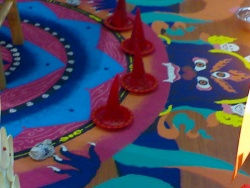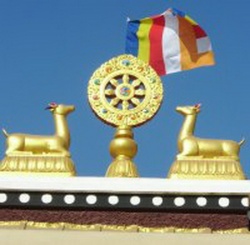Color Symbolism in Buddhism
Color symbolism is used in a wide variety of fascinating ways in Buddhist art and ritual.
In Buddhism, especially in Tibetan Buddhism, each of five colors (pancha-varna) symbolizes a state of mind, a celestial buddha, a part of the body, a part of the mantra word Hum, or a natural element. (Blue and black are sometimes interchangeable.)
It is believed that by meditating on the individual colors, which contain their respective essences and are associated with a particular buddha or bodhisattva, spiritual transformations can be achieved (see the table below).
Following is a table summarizing the meaning of the main color symbols in Buddhism. Click on the color name for a full article and examples of that color.
(This article on general color symbolism continues below.)
| Color | Blue | Black | White | Red | Green | Yellow |
| General Meanings | coolness, infinity, ascension, purity, healing |
primordial darkness, hate |
learning, knowledge, purity, longevity |
life force, preservation, the sacred, blood, fire |
balance, harmony, vigor, youth, action |
rootedness, renunciation, earth |
| Seen In: | turquoise, lapis lazuli |
black thangkas | White Tara, white elephant |
coral, red thangkas |
Green Tara | saffron robes of monks |
| Emotion, Action | killing, anger |
killing, hatred |
rest and thinking |
subjugation and summoning |
exorcism | restraining and nourishing |
| Transforms: | anger into mirror-like wisdom |
hate into compassion |
delusion of ignorance into wisdom of reality |
delusion of attachment into the wisdom of discernment |
jealousy into the wisdom of accomplishment |
pride into wisdom of sameness |
| Buddha | Akshobhya | n/a | Vairocana | Amitabha | Amoghasiddhi | Ratna-sambhava |
| Part of Hum | the dot (drop) on the crescent |
n/a | the crescent | syllable 'ha' | vowel 'u' | the head |
| Body Part | ears | n/a | eyes | tongue | head | nose |
| Element | air | air | water | fire | n/a | earth |
In addition, there is the Buddhist concept of the "rainbow body," the penultimate transitional state of meditation in which matter begins to be transformed into pure light. It is said to be the highest state attainable in the realm of samsara before the "clear light" of Nirvana.
As the spectrum contains within itself all possible manifestations of light, and thus of color, the rainbow body signifies the awakening of the inner self to the complete reservoir of terrestrial knowledge that it is possible to access before stepping over the threshold to the state of Nirvana.
Understandably, when depicted in the visual arts, due to the profusion of colors, the result is spectacularly unique.
In a spectacular visualization, the Tibetan tradition states that the syllable hum (part of Om Mani Padme Hum), although blue in color, radiates five different colors.
The dot (drop) on the crescent should be blue, the crescent is white, the head is yellow, the syllable 'ha' is red and the vowel 'u' is of green color.
The four elements air, fire, water and earth are also identified in the Kalachakra-tantra with four different colors: blue (or black), red, white and yellow, respectively.
These four elements are further depicted as semi-circular, triangular, circular, and square respectively. This is a precursor to Tantric imagery where color and geometry (not mutually exclusive) are the basic building blocks making up the whole edifice of Tantric symbolism.
Color symbolism is also of great importance in a mandala, the quintessential symbol of Tibetan Buddhism. The Mahavairochana-Sutra states that a should be painted in five colors: one should start at the interior of the mandala with white and to be followed by red, yellow, blue and black.
The Chakrasambhara-tantra prescribes that the walls of a mandala should be painted in five colors and should maintain the order of black in the interior followed by white, yellow, red and green.
In certain mandalas, the four directions within the palace are indicated by different colors. The east is indicated by white, west by red, north by green and the south by yellow while the center is painted blue.
The Kalachakra-tantra, however, prescribes a different color scheme to indicate different directions: the color black indicates east, yellow west, white north, and red stands for the south. Whatever the color association with directions, the protecting circle of a mandala is almost always drawn in red.

